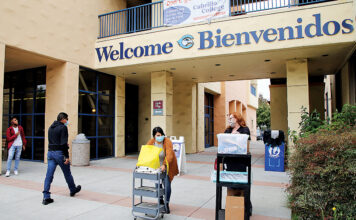CALIFORNIA—As California deals with a surge of Covid-19 cases, hope is in sight as the vaccine begins to be administered to healthcare workers and long-term care residents.
And on Jan. 13, Gov. Gavin Newsom declared that farmworkers would be included in the next tier.
The announcement came after numerous leaders and organizations urged the state to prioritize the population, who have been deemed essential to the nation’s food supply yet have received little to no federal assistance during the pandemic. This oversight has led to much higher infection rates amongst the predominantly Latinx workforce.
Assemblyman for California’s 30th district and Vice Chair of the Latino Legislative Caucus Robert Rivas said he was “very thankful” to the state for answering the appeal.
“This effort is something I’ve been advocating for, as have many of my colleagues,” he said. “After the devastation [farmworkers] have encountered… Making the vaccine available to them is a great first step.”
Guidelines designate that grocery, meat processing, food and agriculture workers are part of Tier One of Phase 1B of the vaccine rollout, along with education and childcare workers, emergency service workers, and individuals 65 and older.
Still, the federal government has left it up to states and counties to develop their own plans for distribution, resulting in confusion and slower rollouts than planned.
“It’s been a huge logistical failure on the part of the federal government,” Rivas said. “They did nothing. So states have been doing all these different things. This is why I am so thankful for our local efforts.”
California is home to the largest population of farmworkers in the country. The Center for Farmworker Families organization has reported that more than 70% of them are undocumented, which Rivas said has been a major barrier in communicating information about the vaccine.
“We’ve had four years of anti-immigrant rhetoric coming from the top of this country’s administration,” he said. “There’s so much fear, mistrust and misinformation. We’ve been trying to build positive relationships… to ensure education and outreach. To make sure they are comfortable. ”
Rivas acknowledged the work of experts, stakeholders and other partners who have been helping the Latino Legislative Caucus in its efforts to bring help, including Spanish-language information, to communities. He singled out Dr. Max Cuevas, CEO of Clinica de Salud del Valle, who has been on the frontline in Salinas since the first days of the pandemic.
In Santa Cruz County, more than half of Covid-19 cases have been identified in Watsonville, despite the city having less than a quarter of the county’s population, and Latinx residents have been disproportionately affected.
Watsonville Mayor Jimmy Dutra echoed Rivas’ observance of mistrust within the farmworker community.
“They’ve been hit so hard,” he said. “They’re afraid of getting sick. They don’t want to be in the same pain they’re seeing their friends and family go through. It’s up to us to show them that [the vaccine] is safe, that it will save lives.”
Dutra said he and other city officials also sent a letter to Newsom last year urging the state to prioritize farmworkers.
“These are essential workers, put in extreme conditions that are unsafe,” he said. “They live in housing that puts them at greater risk. I’m pleased [the state] decided to put them in a higher tier. It brings hope.”
A mass vaccination center, which will be run with help from Salud Para La Gente, is scheduled to open at the Fairgrounds next week, Dutra said. But how fast they will be able to start vaccinating farmworkers depends on when and how many doses are available. Dutra said the county is currently struggling with a shortage—only about 200 doses arrived this week.
“Everything depends on when it gets here, and how much we get,” he said. “We need things to start moving faster.”
County officials have been working with the county farm bureau to make it easily available to farmworkers. This may include taking them in buses to vaccine centers, or bringing pop-up centers directly to their work.
Dutra added that they must remain flexible, as orders are continually changing. Just last week, Newsom opened up Tier 1 vaccines to residents 65 and older, instead of the initial 75 and older decision. This might bump farmworkers a bit lower.
“The Governor’s decisions have been very fluid,” Dutra said. “He’s been moving things around… So for farmworkers, it will probably be another month. We’ll see.”











